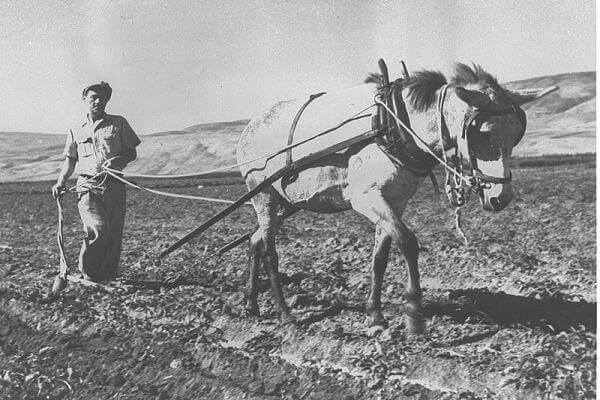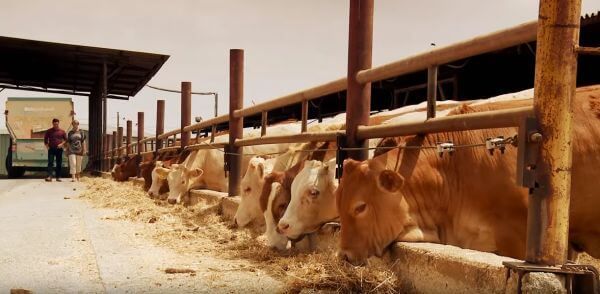The kibbutz movement is one of the pillars of the State of Israel. It is a uniquely Israeli institution, beloved by many. But what are the origins of the kibbutz, and does it have a future in the modern State of Israel?
The Kibbutz Movement Origins
Jews arriving in Ottoman Palestine from Eastern Europe at the turn of the century were influenced by the revolutionary socialist ideals from their home countries. Rejecting earlier Jewish settlements that utilized Arab labor, they sought a “conquest of Labor,” believing that only Jewish labor would lead to the land being redeemed and a Jewish state being established.
While these early pioneers sought to work the land themselves, they could not compete with experienced Arab laborers who would work for less pay. In order to meet the needs of the new pioneers, the Zionist Settlement Office set up agricultural schools.
A group from the school was sent to work on land near the Sea of Galilee then called Um Juni. They left after less than one year. A new group of pioneers who were successful at farming on land near Hadera was sent to Um Juni with the hopes of similar success. They faced many challenges, including crumbling infrastructure left by the past group, as well as attacks from local Arabs.
This group of pioneers were the first to stay in one place and not move to another settlement, like other socialist Jews were doing at the time. They decided to rename the settlement Degania, after the word dagan, Hebrew for the cereals they were growing, and after degania, the cornflowers that grew in the area. Kibbutz Degania became the first kibbutz in Israel in 1910 .
Join the fight for Israel’s fair coverage in the news
Life in Degania, and other early kibbutzim in general, was difficult. The land was difficult to work with and uncultivated, as well as most new immigrants coming from Europe having little to no farming experience. Arabs living near new Jewish settlements also largely resented their presence, and plundering was common. Because of this, early Jewish settlers created the Hashomer defense force.
Kibbutzim served as centers for absorption of new immigrants and provided defense fighters to the Haganah during Mandate Palestine.

Changes
Initially, kibbutzim were almost entirely agricultural, and entirely socialist. Families lived in modest, similar housing, and all meals were eaten communally in the dining hall. In some kibbutzim, children slept in a children’s house at night rather than with their parents. All income earned went into the kibbutz, and it would then be split communally and equally. There was no link between individual contribution to the community and income.
In the 1960s, only four percent of Israelis lived on kibbutzim, yet members of the kibbutz movement made up 15% of the Knesset.
But in the 1980s, Israel faced an economic crisis, and the kibbutzim were especially hurt. Due to mounting debts, inflation, and people leaving for the for cities, the kibbutz movement decided that maintaining a fully socialist framework would be impossible. Most moved to partially privatize.
By 2015, only two members of the Knesset were members of a kibbutz. The weakening of the political power of kibbutzim correlated with a weakening of the Labor Zionism movement as a whole.

The Kibbutz Today
Today’s kibbutzim follow one of three economic models:
- The Communal Kibbutz: Division of income is communal and equal, not depending on one’s individual contribution to the community;
- The Integrated Kibbutz: A member’s individual income is based on an initial, equal sum given to each kibbutz member, an additional sum based on how long they have lived on the kibbutz, and an additional sum based on salary/contributions to the kibbutz;
- The Renewed Kibbutz: Division of income is differential. The more one earns, the more one receives. However, a certain percentage is deducted from each kibbutz member’s salary to cover community expenses and supplement the income of members whose income falls below the minimum salary set by the kibbutz.
The vast majority of kibbutzim today, almost 190, chose to become “renewed kibbutzim,” seeing themselves as “reformers,” adapting the kibbutz method to the economic and social changes of the 21st century. Around 60 kibbutzim operate on the communal method while 20 are integrated.
Join the fight for Israel’s fair coverage in the news
All kibbutzim function as democracies, with members voting to formulate policy, elect officers, authorize the kibbutz budget, and approve new members. Kibbutz members also elect members to committees, who make decisions affecting things such as housing, finance, production, planning, health, and culture.
Kibbutzim production makes up 5.2% of Israel’s gross national product, and 9.2% of Israel’s industrial production. While kibbutzim are less powerful agriculture producers than they used to be, they still leave a huge impact on the state, with 34% of all of Israel’s agriculture coming from kibbutzim. Kibbutzim own 10% of the land within the state.
Related reading: The Roots of Zionism
The Kibbutz Movement’s Future
Kibbutzim today have expanded far beyond the small, socialist communes they once were. Many industries that operate on kibbutzim are traded on the Tel Aviv and foreign stock exchanges.
Israelis are also taking these ideals to 100 so-called “urban kibbutzim” where an estimated 2,000 Israelis live. The urban kibbutz movement has sprouted abroad as well, especially in the US, Australia and Germany.
Many believe that the kibbutz movement is having a revival, with kibbutzim expanding and people moving from cities to the periphery to experience the rural kibbutz lifestyle. Most argue that this expansion is only possible due to the evolution of the kibbutzim.
It is also clear that this expansion is not aided by a political expansion of the labor movement. It is something deeper – something calling people to abandon the ease of city life and come to live on kibbutzim, taking the 100 year-old movement into the 21st century.
In short, the kibbutz is here to stay in the modern State of Israel.
Liked this article? Follow HonestReporting on Twitter, Facebook, Instagram and TikTok to see even more posts and videos debunking news bias and smears, as well as other content explaining what’s really going on in Israel and the region.
Images: Degania-B via Wikimedia Commons; cows via YouTube/TBN Israel;
Before you comment on this article, please note our Comments Policy. Any comments deemed to be in breach of the policy will be removed at the editor’s discretion.


